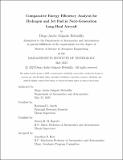Comparative Energy Efficiency Analysis for Hydrogen and Jet Fuel in Next-Generation Long-Haul Aircraft
Author(s)
Salgado Bobadilla, Diego Andre
DownloadThesis PDF (1.004Mb)
Advisor
Speth, Raymond L.
Barrett, Steven R. H.
Terms of use
Metadata
Show full item recordAbstract
The aviation sector aims to reach net-zero CO₂ emissions by 2050. Consequently, the industry must rely on a fuel with no life-cycle CO₂ emissions. Liquid hydrogen offers the potential to provide zero in-flight CO₂ emissions and low life-cycle CO₂ if produced from non-fossil electricity. While wide-body aircraft account for approximately 43% of in-flight CO₂ emissions, few studies have focused on hydrogen-powered aircraft of this size. Additionally, the performance of these aircraft in off-design missions is not typically discussed in the literature. A first-principles based approach was used to model long-haul hydrogen-powered aircraft and quantify fuel burn performance across a range of off-design missions. No engine thermodynamic improvements from using cryogenic fuel were assumed. Furthermore, sensitivity analyses were performed with respect to aircraft design range, material structural strength, and engine performance. This study shows that hydrogen-powered aircraft require roughly 2% less fuel energy at the design mission than conventional jet fuel aircraft. However, hydrogen-powered aircraft require approximately 10-30% more fuel energy for off-design missions between 1,000 and 4,000 nmi compared to jet fuel aircraft. While reducing the design range to cover 95% of all wide-body flights decreases this off-design fuel burn penalty, LH₂ aircraft still have a 5-25% increase in energy required to fly missions between 1,000 and 4,000 nmi relative to conventional aircraft. Additionally, the study indicates that improving material strength or engine performance only has a marginal effect on the relative fuel energy required between LH₂ and jet fuel aircraft.
Date issued
2023-06Department
Massachusetts Institute of Technology. Department of Aeronautics and AstronauticsPublisher
Massachusetts Institute of Technology